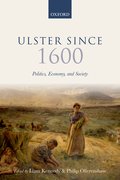By Philip Ollerenshaw
For many people the terms Ulster, Northern Ireland, and ‘the North’ conjure up images of communal conflict, sectarianism, and peace processes of indefinite duration. More than 3,500 people were killed in the national, communal and sectarian conflict that engulfed Northern Ireland between 1969 and Easter 1998 when the Good Friday Agreement was signed. Tens of thousands were injured or maimed, while sporadic acts of political violence persist to this day.
The near-present is a powerful influence on how we view the past. Yet, in many respects, these blood-spattered years serve to distort our understanding of the lived experience of people in Ulster from 1700 onwards. True enough, this was an ethnically-divided society, but one characterised by complexities, ambiguities, contrariness and the unexpected. Above all, it is necessary to appreciate that violence was not the dominant motif in most time periods in recent centuries.
In 1600, Ulster was a thinly populated, economically backward region. By 1900, without the benefit of local coal or iron, the Belfast region had emerged as a significant industrial and commercial centre in western Europe. This social and economic dynamism was based, first, on linen textiles and later on shipbuilding and engineering. Elsewhere in Ulster, more traditional but vigorous small-farming enterprises predominated.
The story of Ulster since 1600 is one of dramatic transformation, in which immigrant entrepreneurs and workers played a vital role. Moreover, in terms of economic geography and social networks, east Ulster was well placed to benefit from the English and Scottish industrial revolutions. In fact, the north east of Ireland was the only part of the island of Ireland to experience modern industrialisation and urbanisation on a major scale. By the time of political independence in ‘southern’ Ireland, Belfast stood out as Ireland’s only industrial city.
But here is one of the many paradoxes. Despite these modernising tendencies, Belfast and the lesser towns of Ulster incubated and perpetuated forms of politico-religious conflict that have outlived similar tendencies that were once characteristic of many parts of western Europe.
There are other paradoxes. The economic trajectory of Ulster in the eighteenth century, though marred by periodic crises, was generally upwards. Yet the province of Ulster experienced higher levels of emigration, particularly to North America, than any of the other Irish provinces. These emigrants, Presbyterians in the main, went on to forge other lives in the New World. A disproportionate number were involved on the insurgents’ side in the American war of independence. At home, a minority of Presbyterians were active in the radical United Irishmen, seeking reform of the Anglican and landlord-dominated Irish political system.
Presbyterian radicalism took a new turn in the following century, focusing on reform of the landlord and tenant system and local government, but within the framework of the Union of Britain and Ireland. The industrial success of east Ulster in turn served to solidify support for the Union, among Protestant workers as well as captains of industry, aided by a resurgent Orange Order. The comparative underdevelopment of the south and west of Ireland provided ideological justification for emerging Irish nationalist and Catholic opposition to the Union. It is significant, though, that members of the Catholic working class in Belfast, Derry and Newry were not swayed by economic arguments. In conjunction with their co-religionists, they sought Home Rule and later political independence for all of Ireland.
The partition of the island in 1920-21, with six of the original nine Ulster counties forming the new statelet of Northern Ireland, was a major source of grievance to Irish nationalists, North and South. Yet much of social and cultural life proceeded as before – arguably the continuities were as important as the discontinuities – though the heat and invective of political partisanship was sometimes imported into activities as diverse as sport, schooling and language revival.
The formative phase in the making of modern Ulster was undoubtedly during the Plantation of Ulster. But maybe Ulster was a place apart, even before then, as Estyn Evans has suggested? Indeed has the distinctiveness of Ulster in recent centuries been overstated, as some others have suggested? These, and many other questions, find at least partial answers within the pages of Ulster Since 1600.
Philip Ollerenshaw is Reader in History at the University of the West of England, Bristol. He is the author or editor of several books on economic, financial, and urban history, including Ulster since 1600: Politics, Economy, and Society (co-edited with Liam Kennedy; OUP, 2012) .
Subscribe to the OUPblog via email or RSS.
Subscribe to only British history articles on the OUPblog via email or RSS.
Subscribe to only history articles on the OUPblog via email or RSS.




Recent Comments
There are currently no comments.